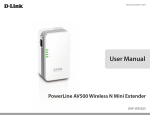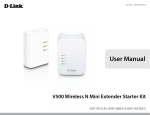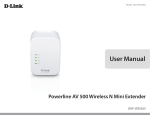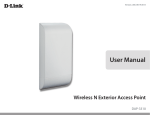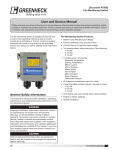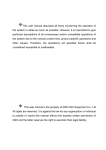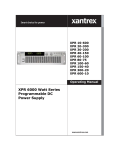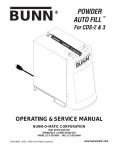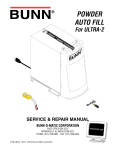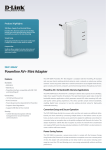Download D-Link DHP-W310AV
Transcript
Version 1.10 | 08/12/2014 User Manual Powerline AV 500 Wireless N Mini Extender DHP-W310AV Preface D-Link reserves the right to revise this publication and to make changes in the content hereof without obligation to notify any person or organization of such revisions or changes. Manual Revisions Revision Date 1.10 August 25, 2014 Description • Trademarks and power usage revision Trademarks D-Link and the D-Link logo are trademarks or registered trademarks of D-Link Corporation or its subsidiaries in the United States or other countries. All other company or product names mentioned herein are trademarks or registered trademarks of their respective companies. Apple®, Apple logo®, Safari®, iPhone®, iPad®, iPod touch® and Macintosh® are trademarks of Apple Inc., registered in the U.S. and other countries. App StoreSM is a service mark of Apple Inc. Chrome™ browser, Google Play™ and Android™ are trademarks of Google Inc. Internet Explorer®, Windows® and the Windows logo are trademarks of the Microsoft group of companies. Copyright © 2014 by D-Link Corporation, Inc. All rights reserved. This publication may not be reproduced, in whole or in part, without prior expressed written permission from D-Link Corporation, Inc. Power Usage This device is an Energy Related Product (ErP) with High Network Availability (HiNA), and automatically switches to a power-saving Network Standby mode within 1 minute of no packets being transmitted. It can also be turned off through a power switch to save energy when it is not needed. Network Standby: 4.11 watts Switched Off: 0.27 watts D-Link DHP-W310AV User Manual 2 Table of Contents Table of Contents Product Overview............................................................... 5 Package Contents.......................................................................... 5 System Requirements.................................................................. 6 Introduction.................................................................................... 7 Connections............................................................................ 8 Side............................................................................................. 9 LEDs..........................................................................................10 Hardware Installation......................................................11 Wireless Installation Considerations.....................................12 Powerline Installation Considerations.................................13 Safety...............................................................................................14 Configuration....................................................................15 Setup................................................................................................15 Hybrid Link Setup................................................................16 Wireless Settings..................................................................17 LAN Settings..........................................................................18 LAN Settings - Static IP..................................................19 PLC Settings ..........................................................................20 Advanced.......................................................................................21 MAC Address Filter..............................................................21 Advanced Wireless..............................................................22 User Limit................................................................................23 Tools.................................................................................................24 Admin......................................................................................24 System.....................................................................................25 D-Link DHP-W310AV User Manual Firmware.................................................................................26 Time..........................................................................................27 System Check........................................................................28 Status...............................................................................................29 Device Info.............................................................................29 Logs..........................................................................................30 Statistics..................................................................................31 Wireless...................................................................................32 IPv6...........................................................................................33 Support...........................................................................................34 Connecting to a Wireless Network..................................35 WPS Button....................................................................................35 Windows® 8....................................................................................36 WPA/WPA2.............................................................................36 Windows® 7....................................................................................38 WPA/WPA2.............................................................................38 Windows Vista®.............................................................................41 WPA/WPA2.............................................................................42 Windows® XP.................................................................................44 WPA/WPA2.............................................................................45 Troubleshooting...............................................................47 Wireless Basics .................................................................49 What is Wireless?..........................................................................50 Tips....................................................................................................52 Wireless Modes.............................................................................53 3 Table of Contents Networking Basics............................................................54 Check your IP address................................................................54 Statically Assign an IP address................................................55 Technical Specifications...................................................56 D-Link DHP-W310AV User Manual 4 Section 1 - Product Overview Product Overview Package Contents D-Link DHP-W310AV Powerline AV 500 Wireless N Mini Extender CAT5 Ethernet Cable CD-ROM with Software and User Manual Wi-Fi Configuration Note Wi-Fi Configuration Card D-Link DHP-W310AV User Manual 5 Section 1 - Product Overview System Requirements • An Ethernet-based cable or DSL modem • IEEE 802.11n or 802.11g wireless clients • 10/100 Ethernet clients Network Requirements Computer with the following: • Windows®, Macintosh, or Linux-based operating system • An installed Ethernet adapter Web-based Configuration Utility Requirements Browser Requirements: • Internet Explorer 7.0 or higher • Firefox 3.5 or higher • Safari 4.0 or higher • Chrome 8.0 or higher Windows® Users: Make sure you have the latest version of Java installed. Visit www.java.com to download the latest version. CD Installation Wizard Requirements D-Link DHP-W310AV User Manual • • • • • Windows® 7 / Vista® /XP An Ethernet port or wireless interface CD-ROM drive PC with 1.5 Ghz processor 1 GB memory 6 Section 1 - Product Overview Introduction The DHP-W310AV allows you to connect both wired and wireless computers, high-definition TVs, networking devices, and gaming consoles using the most pervasive medium in your home - the electrical wiring. Share Internet connections and experience smooth file transfers, streaming multimedia, online gaming and more. The Powerline AV Wireless N Mini Extender features easy plug-and-play installation and can be connected to any Ethernet-enabled device. The DHP-W310AV incorporates the latest technology to improve on the AV technology’s data speeds over a home’s existing electrical wiring. This fast transmission speed provides ample bandwidth suitable for streaming high-quality video HDTV signals while simultaneously providing high-speed Internet access throughout the home. With Quality of Service (QoS) support, the performance of applications which require real-time communication, such as VoIP phonecalls and multiplayer online games, will not be compromised even while streaming Internet TV and music. Data Transmission Over electrical Wiring The D-Link DHP-W310AV Powerline AV 500 Wireless N Mini Extender, compliant with the HomePlug AV standard, uses your home’s existing electrical wiring1 to create a network or extend your existing network. It turns every power outlet into a potential network connection to access digital media devices, game consoles, print servers, computers, and network storage devices throughout your home. Additionally, Wireless N provides high speed transfers without the need for unsightly network cables. Faster Wireless Speeds & Wider Operational Range The Wireless N technology incorporated into the DHP-W310AV offers increased speed and range beyond standard 802.11g technology. Initial wireless setup can be accomplished quickly, thanks to a convenient setup wizard. WPA and WPA2 encryption keep your network traffic safe and secure. Ideal For Bandwidth-Intensive Applications The DHP-W310AV is capable of delivering Powerline AV data transfer rates even higher than the old AV standard. This rapid transmission speed makes it ideal for bandwidth-intensive applications, guaranteeing smooth HD video streaming, clear VoIP calls, and lag-free online gaming experiences. In addition, it prioritizes Internet traffic, ensuring that multimedia applications do not experience glitches while web surfing and downloads are in progress. This device provides ample network bandwidth, enabling digital home consumers to tap into existing electrical wiring for high-quality multimedia streaming. Convenient Setup and Secure Operation The DHP-W310AV plugs directly into a power outlet, and does not require any additional cables. Extend your home network by connecting multiple devices in the farthest corners of your home via Ethernet cable or Wireless N. For convenient setup, wired or wireless encryption keys can be quickly configured with the push of a button on top of the device. The adapter implements 128‑bit AES data encryption to protect the network from unauthorized wiretapping. With hassle-free plug and play installation, the DHP-W310AV is an ideal solution to create a wall-to-wall home network. Power outlets and electrical wiring must all be part of the same electrical system. Certain electrical conditions in your home, such as wiring condition and configuration, may affect the performance of this product. Additional D-Link Powerline AV adapters are required to add new devices to the network. A minimum of two D-Link Powerline AV Network Adapters are required to create a network. Connecting this product to a power strip with a surge protector may adversely affect the performance of this product. For best results, plug the adapter directly into a wall outlet. 1 D-Link DHP-W310AV User Manual 7 Section 1 - Product Overview Hardware Overview Connections 1 2 1 ON/OFF Switch 2 RJ-45 10/100BASE-TX Ethernet Port Turns the device ON or OFF. Use an Ethernet cable to connect to to PCs, game consoles, and network storage Devices. 1 D-Link DHP-W310AV User Manual 8 Section 1 - Product Overview Hardware Overview Side 1 2 1 Reset Button 2 Common Connect Button D-Link DHP-W310AV User Manual Press and hold the button for 5 seconds to reset the device to factory default settings. Push this button to create a secure Powerline connection with another adapter. It can also be used to connect using Wi-Fi Protected Setup (WPS). To connect using WPS, press this button, then press the WPS button on your wireless client. 9 Section 1 - Product Overview Hardware Overview LEDs 2 4 1 3 A solid light indicates a proper connection to the power supply. A blinking light indicates it is in sleep mode or seeking a Powerline connection. 1 Power LED 2 Wireless LED 3 Powerline LED A solid light indicates that a Powerline connection is established. 4 Ethernet LED A solid light indicates a connection to an Ethernet-enabled device. D-Link DHP-W310AV User Manual 2 A solid light indicates that the wireless segment is ready. 10 Section 2 - Installation Hardware Installation Note: A minimum of two Powerline devices (your DHP-W310AV and another pre-existing device) are required to create a Powerline network. Power Plug the DHP-W310AV into an AC wall outlet where you want to extend your network. The Power LED on the DHP-W310AV will turn on to indicate it is receiving power. This may take up to 60 seconds. Plug in the Ethernet Cable Connect one end of the supplied CAT5 Ethernet cable to the Ethernet port on the DHP-W310AV and the other end of the cable to the device’s Ethernet interface. Connect to Existing Network Press the Common Connect Button on the existing Powerline AV device for 3 seconds. Then, press the Common Connect Button on the DHP-W310AV Powerline AV 500 Wireless N Mini Extender for 3 seconds. This must be done within two minutes after pressing the Common Connect Button on the first device. The Powerline devices will reboot. Read the Wi-Fi advice on the next page, and continue to Configuration. Note: Network connectivity is confirmed when the Powerline LEDs indicators on both Powerline devices are steadily lit. This will indicate that your network is now secure. ROOM A ROOM B ROOM C DHP-308AV iPad Internet D-Link DHP-W310AV User Manual Router DHP-W310AV Notebook iPad DHP-W310AV Notebook 11 Section 2 - Installation Wireless Installation Considerations The DHP-W310AV lets you access your network using a wireless connection from anywhere within the operating range of your wireless network. Keep in mind that the number, thickness and location of walls, ceilings, or other objects that the wireless signals must pass through may limit the range. Typical ranges vary depending on the types of materials and background RF (radio frequency) noise in your home or business. The key to maximizing wireless range is to follow these basic guidelines: 1. Keep the number of walls and ceilings between the DHP-W310AV and other network devices to a minimum. Each wall or ceiling can reduce your adapter’s range by 3-90 feet (1-30 meters.) Position your devices so that the number of walls or ceilings is minimized. 2. Be aware of the direct line between network devices. A wall that is 1.5 feet thick (.5 meters) at a 45-degree angle appears to be almost 3 feet (1 meter) thick. At a 2-degree angle it looks over 42 feet (14 meters) thick! Position devices so that the signal will travel straight through a wall or ceiling (instead of at an angle) for better reception. 3. Building materials make a difference. A solid metal door or aluminum studs may have a negative effect on range. Try to position the wireless DHP-W310AV and computers so that the signal passes through drywall or open doorways. Materials and objects such as glass, steel, metal, walls with insulation, water (fish tanks), mirrors, file cabinets, brick, and concrete will degrade your wireless signal. 4. Keep your product away (at least 3-6 feet or 1-2 meters) from electrical devices or appliances that generate RF noise. 5. If you are using 2.4 GHz cordless phones or wireless products such as ceiling fans, lights, and home security systems, your wireless connection may degrade dramatically or drop completely. Make sure your 2.4 GHz phone base is as far away from your wireless devices as possible. The base transmits a signal even if the phone is not in use. D-Link DHP-W310AV User Manual 12 Section 2 - Installation Powerline Installation Considerations Plan the location of your Powerline devices: 1. Connect Powerline devices to electrical outlets that are not controlled by a wall switch to avoid accidentally turning off power to the device. 2. Do not connect the Powerline devices to an extension cord, surge protector, or power strip as this might prevent it from working correctly, or negatively impact network performance. 3. Avoid using the Powerline devices in an electrical outlet that is located near an appliance that uses a lot of power, such as a washer or dryer, or a refrigerator. This may prevent the adapter from working correctly, or negatively impact network performance. 4. Verify that your Powerline devices are electrically rated to operate with the power available in your location. 5. To help prevent against electrical shock, be sure to plug the power cables into properly grounded electrical outlets. D-Link DHP-W310AV User Manual 13 Section 2 - Installation Safety Please read all of the safety and operating instructions before using your device: 1. Do not open the device or attempt to repair or service the device. 2. Ensure that the device is plugged into the wall in a vertical position. 3. Use the device in a dry location, and avoid placing it in humid environments. 4. Do not submerge the device in liquid or attempt to clean it with liquids or solvents. To clean the device, disconnect it from the power outlet and use a damp towel. 5. Keep the device out of direct sunlight. 6. Do not cover or block the vents on the device. 7. Make sure that the device has adequate room for ventilation. 8. Avoid placing the device near a heater or radiator. D-Link DHP-W310AV User Manual 14 Section 3 - Configuration Configuration Setup If you wish to change the default settings or optimize the performance of the DHP-W310AV, you may use the web-based configuration utility. To access the configuration utility, open a web browser such as Internet Explorer and enter either http://dlinkapWXYZ.local. (this is on the Wi-Fi Configuration Card) or http://192.168.0.50 in the address field. By default, Admin will be the User Name . Leave the password blank. If you receive a “Page Cannot be Displayed” error, please refer to Troubleshooting on page 47 for assistance. You will automatically proceed to the Setup heading after logging in. D-Link DHP-W310AV User Manual 15 Section 3 - Configuration Hybrid Link Setup Use the wizard’s on-screen incstructions to conveniently set up your network if you have not yet. You can also manually configure your network. Wi-Fi settings are covered at Wireless Settings on page 17 and Powerline settings are at PLC Settings on page 20. D-Link DHP-W310AV User Manual 16 Section 3 - Configuration Wireless Settings The DHP-W310AV lets you customize your wireless settings for your access point. This device allows you to extend your current network so you can roam about the house while staying connected the entire time. Hybrid Router Wi- If you are connected to a hybrid Powerline Fi Network Name: router that also broadcasts Wi-Fi, you will see that router’s network name (SSID) here. Extended Wi-Fi When you are browsing for available wireless Network Name: networks, this is the name that will appear in the list. You can choose to extend the same network that your hybrid router is broadcasting (listed above) for convenient whole-home access. As you walk from one area of coverage to another, your device will detect the stronger signal and automatically keep you connected. You may also put the DHP-W310AV on a different network. Wireless Security & WPA/WPA2 is more secure than WEP. WEP WPA: should only be used if you have older devices that are unable to use WPA. Use of TKIP/AES security framework provides the optimum mix of security and compatibility. Please refer to Wireless Basics on page 49 for more information. Password: Choose a password that is strong. A good password uses both letters and numbers in unpredictable places. Example bad passwords could be password or 12345678. D-Link DHP-W310AV User Manual 17 Section 3 - Configuration LAN Settings This section will allow you to change the local network settings of the DHP-W310AV and to configure the DHCP settings. Device Name: Enter the Device Name of this DHP-W310AV. You will use this name to connect to it through a web browser. The default name is listed on your Wi-Fi Configuration Card. LAN Connection Use the drop-down menu to select Dynamic Type: IP (DHCP) to automatically obtain an IP address on the LAN/private network. For Static IP setup, see the next page. IPv6 Connection Your Internet Service Provider (ISP) may Type: require this to be set a certain way for Internet access. Contact your ISP regarding such requirements. LAN IPv6 Address This shows the current IPv6 address of the Settings: DHP-W310AV on your network. Save Settings: Click Save Settings to save and activate the new changes. D-Link DHP-W310AV User Manual 18 Section 3 - Configuration LAN Settings - Static IP Select Static IP to manually enter the IP address, subnet mask, and default gateway addresses. LAN Connection Select Static IP from the drop-down menu. Type: IP Address: Enter the IP address of the DHP-W310AV. The default IP address is 192.168.0.50. If you change the IP address, once you click Apply, you will need to enter the new IP address in your browser to return to the configuration utility. You can also connect with the device name. (See previous page.) Subnet Mask: Enter the Subnet Mask. Default Gateway: Enter the Gateway. This is usually the LAN or internal IP address of your router. DNS Server: This is the Domain Name Server that looks up addresses on the Internet, you may have a specific one you need to connect to. Save Settings: Click Save Settings to save and activate the new changes. D-Link DHP-W310AV User Manual 19 Section 3 - Configuration PLC Settings This section will show you how to configure your new D-Link Powerline AV using the web-based configuration utility. Power Saving: Power save mode. Network You can set the name of your network and to make Name: it either public or private. Make sure the Network Name of all of the devices within your Powerline network is the same. Public Select this option if you would like to make Network your Powerline network public with the default Name: Network Name of “HomePlugAV”. Since this is a commonly used Network Name, it is less secure than a private Network Name. Private Select this option if you wish to make your Network Powerline network more secure by using a private Name: Network Name. Scan: Click this button to scan for new Powerline devices. This is automatically done periodically and upon loading this page. Member List: This section provides information on the Powerline AV devices on your Powerline network. QoS Setting: Here you can set the Quality of Service (QoS) settings for each network device. QoS helps you prioritize network traffic based on device or the port the traffic is on. MAC Address/ Select a device from the Computer Name dropdown box and then click the << above Computer Name to automatically fill in Port Number: the device’s MAC Address. Or, Set the priority for the device under the Priority dropdown box. Clear settings for a rule with the Clear button. Remember to click Save Settings after making changes. D-Link DHP-W310AV User Manual 20 Section 3 - Configuration Advanced MAC Address Filter Use MAC (Media Access Control) Filters to authorize wireless clients to access your network by their MAC addresses. When enabled, you can choose to block the devices listed, or only allow the devices listed. MAC Filtering Set MAC Filtering to ALLOW, DENY, or OFF. Rules: ALLOW means only the devices listed can access the network. DENY means the devices listed cannot access the network. OFF means this function is currently disabled. Description: You may make a note for your convenience, such as “My PC” or “My friend’s smartphone” MAC Address: Enter the MAC address you would like to filter. To find the MAC address on a computer, please refer to “Networking Basics” on page 54. Click Save Settings to activate and save. Note: If you are filtering to ALLOW only the listed devices, make sure to add your own computer to the list or you will be denied access to the network and the configuration utility. If you DENY the listed addresses be sure not to include your computer. Clear: Clear the rule from the list. Note you will have to save the settings in order for it to take effect. Save Settings: Click Save Settings to save and activate the new changes. D-Link DHP-W310AV User Manual 21 Section 3 - Configuration Advanced Wireless The Advanced Wireless section allows you to change several advanced settings on your DHP-W310AV. Most users will not need to modify this section. Transmit Power: Sets the transmit power of the antennas. WMM Enable: WMM is a Quality of Service (QoS) system for your wireless network. Enabling this feature will improve the quality of video and voice applications for your wireless clients. Short GI: Check this box to reduce the guard interval time therefore increasing the data capacity. However, this setting may decrease stability and reliability. IGMP Snooping: Select this checkbox to enable IGMP snooping. IGMP snooping is a layer 2 feature which enables the device to learn Multicast group membership based on IGMP messages passing through the built-in switch. Because the switch learns the IGMP messages and knows which clients are involved in the multicast group membership, it is able to forward multicast traffic only to the ports that requested it (based on their membership). WLAN Partition: Select this checkbox to enable WLAN partition. If this feature is enabled, then there is no barrier between communication among wireless stations connecting to the DHP-W310AV. If this is disabled, wireless clients are not allowed to exchange data through the DHP-W310AV. HT20/40 Enabling this function allows compatibility with both 802.11n devices as well as 802.11b/g at the cost of speed. Disabling Coexistence: this will give higher speeds but only allow 802.11n devices to function. D-Link DHP-W310AV User Manual 22 Section 3 - Configuration User Limit This screen lets you set the maximum number of wireless clients that can connect at one time to your DHP-W310AV Enable User Check the Enable User Limit box to enable Limit: limiting the number of devices that can connect to the DHP-W310AV. User Limit: Enter the maximum number of clients, between 1 and 32. Save Click Save Settings to save and activate the Settings: new changes. D-Link DHP-W310AV User Manual 23 Section 3 - Configuration Tools Admin This page will allow you to change the administrator password, which is used to access the configuration interface and change settings. Password: Enter a new password for the admin user name. The administrator account can change the configuration of the device. Verify Enter the same password that you entered in Password: the previous textbox in order to confirm its accuracy. Enable Enables a CAPTCHA verification which will Graphical require users to type letters or numbers from Authentication: a distorted image displayed on the screen to prevent online hackers and unauthorized users from gaining access to your device’s configuration. This feature is disabled by default. Save Settings: Click Save Settings to save and activate the new changes. D-Link DHP-W310AV User Manual 24 Section 3 - Configuration System This page lets you both save and delete settings on your DHP-W310AV. Save Settings To Use this option to save the current Local Hard Drive: DHP-W310AV configuration settings to a file on the computer you are using. Click the Save button. You will then see a file dialog where you can select a location and file name for the settings. Load Settings From Use this option to load previously saved Local Hard Drive: DHP-W310AV configuration settings. Click Browse to find a previously saved configuration file. Then, click the Upload Settings button to transfer those settings to the DHP-W310AV. Restore to This option will restore all configuration settings back to the settings that were in effect at the time the DHP-W310AV was Factory Default shipped from the factory. Any settings that have not been saved will be lost, including any rules that you have created. If you Settings: would like to save the current DHP-W310AV configuration settings, use the Save button above. Reboot the Device: Clear Language Pack: Click to reboot the DHP-W310AV. Clears any language pack that is currently installed. For more about language packs, refer to “Firmware” on page 26. D-Link DHP-W310AV User Manual 25 Section 3 - Configuration Firmware You can upgrade the firmware of the DHP-W310AV from this page. Make sure the firmware you would like to use is on the local hard drive of your computer. Click Browse... to locate the firmware file to be used for the update. Please check the D-Link support site for firmware updates at http://support.dlink.com. You can download firmware upgrades to your hard drive from the D-Link support site. Firmware Click on the blue hyperlink at the top of the Information: page the to find out if there is an updated firmware or language pack. If a new version exists, download the new firmware to your hard drive. Firmware Upgrade: After you have downloaded the new firmware, click Browse... to locate the firmware update on your hard drive. Click Upload to complete the firmware upgrade. Language Pack You can change the interface language of the Upgrade: device by uploading a language pack. To install a language pack, click the Browse... button to locate the D-Link language pack upgrade file on your computer. Once you have found the file, click the Upload button to begin the language pack upgrade process. This can take a minute or more. Finally, wait for the device to reboot. This process can take about 75 seconds. D-Link DHP-W310AV User Manual 26 Section 3 - Configuration Time The Time Configuration option allows you to configure, update, and maintain the correct time on the internal system clock. From this section you can set the time zone that you are in. Daylight Saving can also be configured to automatically adjust the time when needed. Time Zone: Select the Time Zone from the drop-down menu. Daylight Saving: To enable Daylight Saving time adjustment, click the Enable Daylight Saving check box. Next, use the drop-down menu to select a Daylight Saving Offset and then enter a start date and an end date for daylight saving time. Enable NTP Server: NTP (Network Time Protocol) allows the device to automatically set the system clock based on an Internet NTP server. Check this box to use a NTP server. This will only connect to a server on the Internet, not a local server. NTP Server Used: Enter the NTP server or select one from the drop-down menu. Date and Time: To manually input the time, enter the values in these fields for the Year, Month, Day, Hour, Minute, and Second and then click Save Settings. You can also click the Copy Your Computer’s Time Settings button at the bottom of the screen. Save Settings: Click Save Settings to save and activate the new changes. D-Link DHP-W310AV User Manual 27 Section 3 - Configuration System Check This page helps you to diagnose connection problems. Ping Test: A ping test sends a tiny bit of information to a website and anticipates a response. Pinging an extremely stable site such as your favorite search engine or news site can help tell you if your Internet connection is working properly. If you can ping a site or address from here but your computer is getting no connectivity, then the DHP-W310AV is working properly but there is the problem with the computer. IPv6 Ping Test: This is similar to the regular Ping Test but using a IPv6 address. Ping Result: “Ping timeout” means that the site did not respond. This happens if the site is down or does not exist, but also if you do not have Internet connectivity. If you ping several common websites and all result in a timeout then there is likely an issue with your Internet connection. If the result says a site is alive, then your Internet connection is working. D-Link DHP-W310AV User Manual 28 Section 3 - Configuration Status Device Info This page displays the current information for the DHP-W310AV. It will display the LAN and wireless LAN information. General: Displays the DHP-W310AV’s time and firmware version. LAN: Displays the MAC address and the private (local) IP settings for the DHP-W310AV. Wireless LAN: Displays the wireless MAC address and your wireless settings such as SSID and Channel. PLC: Shows the DHP-W310AV ’s Powerline Connection settings. D-Link DHP-W310AV User Manual 29 Section 3 - Configuration Logs The DHP-W310AV keeps a running log of events and activities occurring on the DHP-W310AV. If the AP is rebooted, the logs are automatically cleared. You can save the log files prior to clearing them. Log Options: You can select the types of messages that you would like to display from the log: System Activity, Wireless Activity, Critical, Warning, Information. Select the types you want to view and click Save Settings. Save Log File: Save the log to your hard drive. First Page: Go to the first page of the log. Last Page: Go to the last page of the log. Previous: Go to the previous page of the log. Next: Go to the next page of the log. Clear: This button clears all current log content. D-Link DHP-W310AV User Manual 30 Section 3 - Configuration Statistics The DHP-W310AV keeps statistics on the traffic that passes through it. You can view the amount of packets that pass through the LAN and wireless portions of the network. The traffic counter will reset if the DHP-W310AV is rebooted. D-Link DHP-W310AV User Manual 31 Section 3 - Configuration Wireless This section allows you to view the wireless devices that are connected to your wireless DHP-W310AV. Number of Displays the number of devies that are Wireles Clients: connected to the DHP-W310AV via wireless. SSID: The wireless network’s name. MAC Address: Displays the Ethernet ID (MAC address) of the wireless client. Uptime: Shows how long that device has been connected to the DHP-W310AV. Mode: Shows the mode the device is using to connect to your DHP-W310AV. This should be 11b, 11g, or 11n. Rssi (%): This shows the strength of your device’s connection. D-Link DHP-W310AV User Manual 32 Section 3 - Configuration IPv6 This section will display all of your IPv6 Internet and network connection details. D-Link DHP-W310AV User Manual 33 Section 3 - Configuration Support Click on a link in the Support heading for more information on each section of the firmware. D-Link DHP-W310AV User Manual 34 Section 3 - Configuration Connecting to a Wireless Network WPS Button The easiest and most secure way to connect your wireless devices to the router is WPS (Wi-Fi Protected Setup). Most wireless devices such as wireless adapters, media players, Blu-ray DVD players, wireless printers and cameras will have a WPS button (or a software utility with WPS) that you can press to connect to the router. Please refer to your user manual for the wireless device you want to connect to make sure you understand how to enable WPS. To connect a client, follow the steps below: To connect your wireless devices to the router using WPS: Step 1 - Press the WPS button on the router for about 1 second. The Power/Status LED will start to blink. Step 2 -Within 2 minutes, press the WPS button on your wireless client (or launch the software utility and start the WPS process). Step 3 - Allow up to 2 minutes to configure. Once the Power/Status LED stops blinking, you will be connected and your wireless connection will be secure with WPA2. D-Link DHP-W310AV User Manual WPS Button 35 Section 3 - Configuration Windows® 8 WPA/WPA2 It is recommended to enable wireless security (WPA/WPA2) on your wireless router or access point before configuring your wireless adapter. If you are joining an existing network, you will need to know the security key (Wi-Fi password) being used. To join an existing network, locate the wireless network icon in the taskbar, next to the time display. Wireless Icon Clicking on this icon will display a list of wireless networks which are within connecting proximity of your computer. Select the desired network by clicking on the network name. D-Link DHP-W310AV User Manual 36 Section 3 - Configuration You will then be prompted to enter the network security key (Wi-Fi password) for the wireless network. Enter the password into the box and click Next. If you wish to use Wi-Fi Protected Setup (WPS) to connect to the router, you can also press the WPS button on your router at this point to enable the WPS function. When you have established a successful connection to a wireless network, the word Connected will appear next to the name of the network to which you are connected. D-Link DHP-W310AV User Manual 37 Section 3 - Configuration Windows® 7 WPA/WPA2 It is recommended to enable wireless security (WPA/WPA2) on your wireless router or access point before configuring your wireless adapter. If you are joining an existing network, you will need to know the security key or passphrase being used. 1.Click on the wireless icon in your system tray (lower-right corner). Wireless Icon 2.The utility will display any available wireless networks in your area. D-Link DHP-W310AV User Manual 38 Section 3 - Configuration 3.Highlight the wireless connection with Wi-Fi name (SSID) you would like to connect to and click the Connect button. If you get a good signal but cannot access the Internet, check your TCP/IP settings for your wireless adapter. Refer to the Networking Basics section in this manual for more information. 4.The following window appears while your computer tries to connect to the router. D-Link DHP-W310AV User Manual 39 Section 3 - Configuration 5.Enter the same security key or passphrase (Wi-Fi password) that is on your router and click OK. You can also connect by pushing the WPS button on the router. It may take 20-30 seconds to connect to the wireless network. If the connection fails, please verify that the security settings are correct. The key or passphrase must be exactly the same as on the wireless router. D-Link DHP-W310AV User Manual 40 Section 3 - Configuration Windows Vista® Windows Vista® users may use the built-in wireless utility. If you are using a third-party utility or Windows® 2000, please refer to the user manual of your wireless adapter for help with connecting to a wireless network. Most utilities will have a “site survey” option similar to the Windows Vista® utility as seen below. If you receive the Wireless Networks Detected pop-up, click on the center of the window to access the utility. or Right-click on the wireless computer icon in your system tray (lowerright corner next to the time). Select Connect to a network. The utility will display available wireless networks in your area. Select a network (displayed using the SSID) and click the Connect button. If you have a good signal but cannot access the Internet, check your TCP/IP settings for your wireless adapter. Refer to the Networking Basics section in this manual for more information. D-Link DHP-W310AV User Manual 41 Section 3 - Configuration WPA/WPA2 It is recommended to enable wireless security (WPA/WPA2) on your wireless router or access point before configuring your wireless adapter. If you are joining an existing network, you will need to know the security key or passphrase being used. 1. Open the Windows Vista® Wireless Utility by right-clicking on the wireless computer icon in your system tray (lower right corner of screen). Select Connect to a network. 2. Highlight the wireless network (SSID) you would like to connect to and click Connect. D-Link DHP-W310AV User Manual 42 Section 3 - Configuration 3. Enter the same security key or passphrase that is on your router and click Connect. It may take 20-30 seconds to connect to the wireless network. If the connection fails, please verify that the security settings are correct. The key or passphrase must be exactly the same as on the wireless router. D-Link DHP-W310AV User Manual 43 Section 3 - Configuration Windows® XP Windows® XP users may use the built-in wireless utility (Zero Configuration Utility). The following instructions are for Service Pack 2 users. If you are using another company’s utility, please refer to the user manual of your wireless adapter for help with connecting to a wireless network. Most utilities will have a “site survey” option similar to the Windows® XP utility as seen below. If you receive the Wireless Networks Detected bubble, click on the center of the bubble to access the utility. or Right-click on the wireless computer icon in your system tray (lower-right corner next to the time). Select View Available Wireless Networks. The utility will display any available wireless networks in your area. Click on a network (displayed using the SSID) and click the Connect button. If you get a good signal but cannot access the Internet, check your TCP/ IP settings for your wireless adapter. Refer to the Networking Basics section in this manual for more information. D-Link DHP-W310AV User Manual 44 Section 3 - Configuration WPA/WPA2 It is recommended to enable WPA on your wireless router or access point before configuring your wireless adapter. If you are joining an existing network, you will need to know the WPA key being used. 1. Open the Windows® XP Wireless Utility by right-clicking on the wireless computer icon in your system tray (lower-right corner of screen). Select View Available Wireless Networks. 2. Highlight the wireless network (SSID) you would like to connect to and click Connect. D-Link DHP-W310AV User Manual 45 Section 3 - Configuration 3. The Wireless Network Connection box will appear. Enter the WPAPSK passphrase and click Connect. It may take 20-30 seconds to connect to the wireless network. If the connection fails, please verify that the WPA-PSK settings are correct. The WPA-PSK passphrase must be exactly the same as on the wireless router. D-Link DHP-W310AV User Manual 46 Section 4 - Troubleshooting Troubleshooting This chapter provides solutions to problems that can occur during the installation and operation of the DHP-W310AV. Read the following descriptions if you are having problems. (The examples below are illustrated in Windows® XP. If you have a different operating system, the screenshots on your computer will look similar to the following examples.) 1. Why am I unable to access the web-based configuration utility? When entering the IP address of the D-Link DHP-W310AV (192.168.0.50), you are not connecting to a website on the Internet or have to be connected to the Internet. The device has the utility built-in from the factory. Your computer must be on the same IP subnet to connect to the web-based utility. You may also enter http://dlinkapWXYZ.local. (on the Wi-Fi Configuration Card) instead of the IP address. • Make sure you have an updated Java-enabled web browser. We recommend the following: - Microsoft Internet Explorer® 7.0 and higher - Mozilla Firefox 3.5 and higher - Google™ Chrome 8.0 and higher - Apple Safari 4.0 and higher • Verify physical connectivity by checking for solid link lights on the device. If you do not get a solid link light, try using a different cable or connect to a different port on the device if possible. If the computer is turned off, the link light may not be on. • Disable any internet security software running on the computer. Software firewalls such as Zone Alarm, Black Ice, Sygate, Norton Personal Firewall, and Windows® XP firewall may block access to the configuration pages. Check the help files included with your firewall software for more information on disabling or configuring it. D-Link DHP-W310AV User Manual 47 Section 4 - Troubleshooting • Configure your Internet settings: • Go to Start > Settings > Control Panel. Double-click the Internet Options Icon. From the Security tab, click the button to restore the settings to their defaults. • Click the Connection tab and set the dial-up option to Never Dial a Connection. Click the LAN Settings button. Make sure nothing is checked. Click OK. • Go to the Advanced tab and click the Reset... button to restore these settings to their defaults. Click OK three times. • Close your web browser (if open) and open it. • Access the web management. Open your web browser and enter the IP address of your D-Link DHP-W310AV in the address bar. This should open the login page for your the web management. • If you still cannot access the configuration, unplug the power to the DHP-W310AV for 10 seconds and plug back in. Wait about 30 seconds and try accessing the configuration. If you have multiple computers, try connecting using a different computer. 2. What can I do if I forgot my password? If you forgot your password, you must reset your DHP-W310AV. Unfortunately this process will change all your settings back to the factory defaults. To reset the DHP-W310AV, locate the reset button (hole) on the rear panel of the unit. With the DHP-W310AV powered on, use a paperclip to hold the button down for 5 seconds. Release the button and the DHP-W310AV will go through its reboot process. Wait about 30 seconds to access the DHP-W310AV. The default IP address is 192.168.0.50. When logging in, the username is Admin and leave the password box empty 3. Why can’t my Powerline AV device detect my other Powerline AV devices? This may due to the accidental change of the device password. Use the web-based configuration utility and select Setup > PLC SETTINGS. Fill in the password in the blank. Then repeat the same procedure to the other Powerline AV device via web-based configuration utility. 4. I cannot start my Powerline AV device. Please check your power supply is working. Powerline AV device operates from the power supplied by the home electrical wiring and can not operate without a working power supply. D-Link DHP-W310AV User Manual 48 Section 4 - Troubleshooting Wireless Basics D-Link wireless products are based on industry standards to provide easy-to-use and compatible high-speed wireless connectivity within your home, business or public access wireless networks. Strictly adhering to the IEEE standard, the D-Link wireless family of products will allow you to securely access the data you want, when and where you want it. You will be able to enjoy the freedom that wireless networking delivers. A wireless local area network (WLAN) is a cellular computer network that transmits and receives data with radio signals instead of wires. Wireless LANs are used increasingly in both home and office environments, and public areas such as airports, coffee shops and universities. Innovative ways to utilize WLAN technology are helping people to work and communicate more efficiently. Increased mobility and the absence of cabling and other fixed infrastructure have proven to be beneficial for many users. Wireless users can use the same applications they use on a wired network. Wireless adapter cards used on laptop and desktop systems support the same protocols as Ethernet adapter cards. Under many circumstances, it may be desirable for mobile network devices to link to a conventional Ethernet LAN in order to use servers, printers or an Internet connection supplied through the wired LAN. D-Link DHP-W310AV User Manual 49 Section 4 - Troubleshooting What is Wireless? Wireless or Wi-Fi technology is another way of connecting your computer to the network without using wires. Wi-Fi uses radio frequency to connect wirelessly, so you have the freedom to connect computers anywhere in your home or office network. Why D-Link Wireless? D-Link is the worldwide leader and award winning designer, developer, and manufacturer of networking products. D-Link delivers the performance you need at a price you can afford. D-Link has all the products you need to build your network. How does wireless work? Wireless works similar to how cordless phone work, through radio signals to transmit data from one point A to point B. But wireless technology has restrictions as to how you can access the network. You must be within the wireless network range area to be able to connect your computer. There are two different types of wireless networks Wireless Local Area Network (WLAN), and Wireless Personal Area Network (WPAN). Wireless Local Area Network (WLAN) In a wireless local area network, a device called an access point (AP) connects computers to the network. The access point has a small antenna attached to it, which allows it to transmit data back and forth over radio signals. With an indoor access point as seen in the picture, the signal can travel up to 300 feet. With an outdoor access point the signal can reach out up to 30 miles to serve places like manufacturing plants, industrial locations, college and high school campuses, airports, golf courses, and many other outdoor venues. D-Link DHP-W310AV User Manual 50 Section 4 - Troubleshooting Wireless Personal Area Network (WPAN) Bluetooth is the industry standard wireless technology used for WPAN. Bluetooth devices in WPAN operate in a range up to 30 feet away. Compared to WLAN the speed and wireless operation range are both less than WLAN, but in return it doesn’t use nearly as much power which makes it ideal for personal devices, such as mobile phones, PDAs, headphones, laptops, speakers, and other devices that operate on batteries. Who uses wireless? Wireless technology as become so popular in recent years that almost everyone is using it, whether it’s for home, office, business, D-Link has a wireless solution for it. Home • Gives everyone at home broadband access • Surf the web, check email, instant message, etc. • Gets rid of the cables around the house • Simple and easy to use Small Office and Home Office • Stay on top of everything at home as you would at office • Remotely access your office network from home • Share Internet connection and printer with multiple computers • No need to dedicate office space D-Link DHP-W310AV User Manual 51 Section 4 - Troubleshooting Where is wireless used? Wireless technology is expanding everywhere not just at home or office. People like the freedom of mobility and it’s becoming so popular that more and more public facilities now provide wireless access to attract people. The wireless connection in public places is usually called “hotspots”. Using a D-Link CardBus adapter with your laptop, you can access the hotspot to connect to Internet from remote locations like: airports, hotels, coffee shops, libraries, restaurants, and convention centers. Wireless network is easy to setup, but if you’re installing it for the first time it could be quite a task not knowing where to start. That’s why we’ve put together a few setup steps and tips to help you through the process of setting up a wireless network. Tips Here are a few things to keep in mind, when you install a wireless network. Centralize Your Router or Access Point Make sure you place the router/access point in a centralized location within your network for the best performance. Try to place the router/access point as high as possible in the room, so the signal gets dispersed throughout your home. If you have a two-story home, you may need a repeater to boost the signal to extend the range. Eliminate Interference Place home appliances such as cordless telephones, microwaves, and televisions as far away as possible from the router/access point. This would significantly reduce any interference that the appliances might cause since they operate on same frequency. Security Don’t let you next-door neighbors or intruders connect to your wireless network. Secure your wireless network by turning on the WPA or WEP security feature on the router. Refer to product manual for detail information on how to set it up. D-Link DHP-W310AV User Manual 52 Section 4 - Troubleshooting Wireless Modes There are basically two modes of networking: Infrastructure – All wireless clients will connect to an access point or wireless router. Ad-Hoc – Directly connecting to another computer, for peer-to-peer communication, using wireless network adapters on each computer, such as two or more DIR-850L wireless network CardBus adapters. An Infrastructure network contains an access point or wireless router. All the wireless devices, or clients, will connect to the wireless router or access point. An Ad-Hoc network contains only clients, such as laptops with wireless CardBus adapters. All the adapters must be in Ad-Hoc mode to communicate. D-Link DHP-W310AV User Manual 53 Section 4 - Troubleshooting Networking Basics Check your IP address After you install your new D-Link adapter, by default, the TCP/IP settings should be set to obtain an IP address from a DHCP server (i.e. wireless router) automatically. To verify your IP address, please follow the steps below. Click on Start > Run. In the run box type cmd and click OK. (Windows® 7/ Vista® users type cmd in the Start Search box.) At the prompt, type ipconfig and press Enter. This will display the IP address, subnet mask, and the default gateway of your adapter. If the address is 0.0.0.0, check your adapter installation, security settings, and the settings on your DHP-W310AV. Some firewall software programs may block a DHCP request on newly installed adapters. If you are connecting to a wireless network at a hotspot (e.g. hotel, coffee shop, airport), please contact an employee or administrator to verify their wireless network settings. D-Link DHP-W310AV User Manual 54 Section 4 - Troubleshooting Statically Assign an IP address If you are not using a DHCP capable gateway/DHP-W310AV, or you need to assign a static IP address, please follow the steps below: Step 1 Windows Vista® - Click on Start > Control Panel > Network and Internet > Network and Sharing Center > Manage Network Connections. Windows® XP - Click on Start > Control Panel > Network Connections. Windows® 2000 - From the desktop, right-click My Network Places > Properties. Step 2 Right-click on the Local Area Connection which represents your D-Link network adapter and select Properties. Step 3 Highlight Internet Protocol (TCP/IP) and click Properties. Step 4 Click Use the following IP address and enter an IP address that is on the same subnet as your network or the LAN IP address on your router. Example: If the AP’s LAN IP address is 192.168.0.50, make your IP address 192.168.0.X where X is a number between 2 and 99 (excluding the number 50). Make sure that the number you choose is not in use on the network. Set Default Gateway the same as the LAN IP address of your router (192.168.0.1). Set Primary DNS the same as the LAN IP address of your router (192.168.0.1). The Secondary DNS is not needed or you may enter a DNS server from your ISP. Step 5 Click OK twice to save your settings. D-Link DHP-W310AV User Manual 55 Appendix A - Technical Specifications Technical Specifications Standards • IEEE 802.11n • IEEE 802.11g • IEEE 802.3 • IEEE 802.3u • IEEE P1905.1 draft • IEEE 1901 MSC (0-15) • 130 Mbps (270) • 104 Mbps (216) • 66 Mbps (135) • 52 Mbps (108) • 26 Mbps (54) • 12 Mbps (27) Network Interfaces • One 10/100 Ethernet port • Wireless N • Powerline Frequency Range • 2.4 GHz to 2.497 GHz AC Input • 100 - 240 VAC 50/60 Hz Security • WPA • WEP • WPA2 Wireless Signal Rates* • 300 Mbps • 12 Mbps • 108 Mbps • 11 Mbps • 54 Mbps • 9 Mbps • 48 Mbps • 6 Mbps • 36 Mbps • 5.5 Mbps • 18 Mbps • 2 Mbps • 24 Mbps • 1 Mbps • 117 Mbps (243) • 78 Mbps (162) • 58.5 Mbps (121.5) • 39 Mbps (81) • 19.5 Mbps (40.5) • 6.5 Mbps (13.5) Encryption • 128-bit AES • WEP/WPA/WPA2 Operating Temperature • 32 to 104 °F (0 to 40 °C) Storage Temperature • 14 to 158 °F (-10 to 70 °C) Humidity • Operation: 10% to 90% Relative Humidity • Storage: 5% to 90% Relative Humidity Transmitter Output Power • 13 dBm (+/- 2dB) * Maximum wireless signal rate derived from IEEE Standard 802.11g and 802.11n specifications. Actual data throughput will vary. Network conditions and environmental factors, including volume of network traffic, building materials and construction, and network overhead, lower actual data throughput rate. Environmental factors will adversely affect wireless signal range. D-Link DHP-W310AV User Manual 56 Appendix A - Technical Specifications LEDs • Power • WLAN • Ethernet • Powerline Safety & Emissions • FCC • CE • RoHS • UL, CE LVD Dimensions • 90 x 65 x 50 mm (3.54 x 2.56 x 1.97 inches) Weight • 174.8 g (.38 lbs) D-Link DHP-W310AV User Manual 57

























































